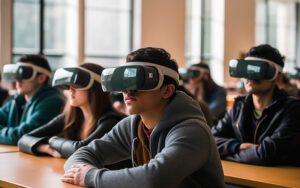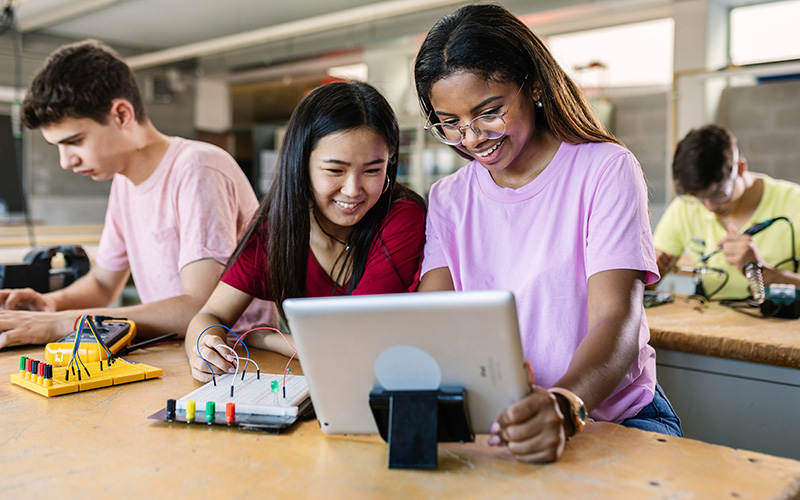Nadav Avni, CMO of Radix Technologies, explores how classrooms are changing in the modern world, imploring more technology.
It’s 2024! Chalkboards, heavy textbooks, and other analogue tools of the past have no place in today’s schools. Over the last few decades, applied technology in the classroom has grown by leaps and bounds. This dovetails nicely with the fact that today’s students are full digital natives who instinctively know their way around smart devices.
Of course, there’s more to education technology than allowing computers in the classroom. School administrators should be continually on the lookout for emerging technologies that can increase student engagement, retain knowledge, and make learning more accessible.
What new technology is out there and being tested in the classroom?
Once upon a time, the school computer lab was a mysterious room frequented by tech enthusiasts and hobbyists. Today, teachers and students have complete access to smartphones, tablets, or laptops in all classes. As a result, we’re seeing a variety of new technologies being tested and used in the classroom to support different learning styles.
Cloud technology
Cloud-based software means computers take up less space than they once did. It also enables schools to trade desktop computers for more portable devices like tablets and laptops.
In addition, students can open cloud-based apps on any school computer and retrieve their saved files by logging into their accounts. If permitted by the school IT administrator, students can even work on their projects at home via remote web logins.
Finally, cloud technology fuels remote learning, which helped save education during the shutdown days of the COVID-19 pandemic. It continues to reduce missed days and downtime due to inclement weather or other disruptions. Instead, students and teachers can meet online and continue their work through files available on the cloud.
Hybrid classes
Before COVID, remote learning was an option for college students who couldn’t attend classes in person. Online and offline learning were two distinct systems: one was entirely remote, while the other was in-person and attendance-based.
However, advances in computer and network technology have enabled educational systems to adopt a hybrid learning model. Those who are able will meet in person, while others attend virtually through the class videoconference portal.
Hybrid classes offer numerous benefits. For instance, it gives teachers the flexibility to create a customised approach to learning. Both teachers and students who have health issues can safely attend class. And for students, it makes school more accessible and affordable and reduces absenteeism.

Active learning
Lectures and memorisation are taking a back seat to active learning. Classroom technology such as tablets, virtual reality (VR), and interactive whiteboards make learning more engaging.
For instance, VR headsets offer unique hands-on training without the cost or risk. By modelling real-world scenarios, students can get in hours of practice time under strict supervision. The virtual environment also gives them unlimited opportunities to get a procedure right.
Tablets and interactive smart boards also encourage active learning through games, competitions, and role playing. To be successful, active learning depends heavily on the student’s participation. New technology enables students to participate in the way that’s most comfortable for them.
What existing tried-and-true technology delivers the best learning experiences?
A critical part of the modern learning process relies on the hardware used in the classroom. Chalkboards and dry-erase markers are alien to preschoolers who already know how to use touchscreens. Similarly, a bulb projector and a VHS player are far more distracting than the HD-quality video screens kids have at home.
Students need classroom devices that reflect what they see in the real world, such as smartphones, tablets, and laptops. Modern technology in the classroom demands advanced equipment that digital natives are familiar with.
The continued drop in prices for LED and touchscreen technologies has led to the popularity of smart TVs and interactive whiteboards in the classroom. Aside from their relative affordability, interactive touchscreens offer the best learning experiences for students who grew up using smartphones and tablets at home.
Touchscreen technology lets teachers and students engage in active learning to the fullest. Multi-touch capabilities allow the entire class to participate in group activities that promote collaboration and cooperation while fostering competition. More importantly, students are far more attentive when they use touchscreen technology. Better engagement means they’ll learn more and retain the knowledge longer.

Considerations for managing technology in the classroom
Interactive touchscreens and other educational technology (EdTech) hardware are significant investments for school districts. As such, they require care and maintenance like any other piece of equipment. At the same time, smart devices are prone to hacking attempts by both bored students and outside parties. Acquire reliable device management software to safeguard this investment and secure your classroom technology.
Software-driven devices require constant updates to the operating system (OS), firmware, and installed applications. But updating and maintaining every device in every classroom can prove inefficient and time-consuming. Instead, device management software can perform updates and maintenance remotely to just one or two devices or the entire fleet. It can also schedule updates after class hours to minimise disruptions. This means units are always updated and ready to serve.
In addition, a robust device manager can secure each device from unauthorised users by assigning varying access levels to end users. For instance, students can only run and operate official learning apps and will have no access to the OS and student files. Instructors can access the content management system and edit student performance reports. Meanwhile, administrators can check student and teacher profiles, monitor learning modules, and gather data on device use. These are valuable sources of insights that can help improve school performance in the future.
More importantly, device management software can protect devices from unwanted attention. Reports of unauthorised attempts to log in will be met with bans and device shutdowns. When threatened with data theft, admins can simply shut down devices remotely or initiate data wipe procedures. If devices go missing, admins can use geolocation services to find them.
Education technology in the classroom is here to stay
Today’s students deserve modern technologies that suit their learning styles and tendencies. Digital natives in particular need an educational system that uses their natural medium of instruction. This means using smart devices like tablets, laptops, and interactive whiteboards to encourage participation and boost engagement.
For schools and school districts, upgrading learning facilities and equipment is a matter of making wise investment choices. When acquiring smart education technology equipment, make room in the budget for proper device managers to keep everything in order. Doing so will ensure that teachers and students alike get the most out of the classroom technology.




